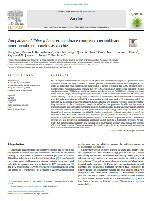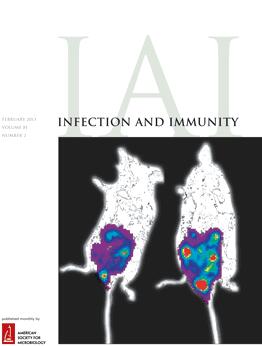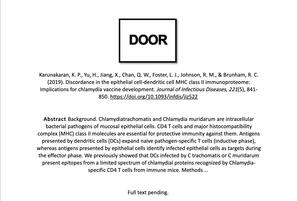Johnson, Raymond M.
Person Preferred Name
Raymond M. Johnson
Related Works
Content type
Digital Document
Abstract
The Chlamydial outer membrane complex (COMC) from the elementary body (EB) is a protein rich insoluble outer membrane shell from which cytosolic proteins have been extracted with detergent. In this study we conducted mass spectrometry experiments to detect proteins in the COMC prepared from C. muridarum EB. Proteomic analysis showed that the COMC contained 75 proteins that included 10 outer membrane proteins (OMPs) such as the major outer membrane protein (MOMP) and polymorphic membrane proteins (Pmps) that were previously identified as CD4 T cell vaccine candidates. We tested the vaccine efficacy of COMC in comparison to individual or combination of recombinant OMPs formulated with Th1 polarizing adjuvant DDA/MPL in two murine genital tract models (C. muridarum and C. trachomatis) by measuring organismal shedding, tubal pathology and immune responses including neutralizing antibodies. In the C. muridarum model, the COMC vaccine generated broadly reactive immune responses against multiple outer membrane proteins, high levels of EB binding and neutralizing antibody and exhibited superior protection against genital infection and pathology when compared to the recombinant PmpG vaccine. Denaturing the COMC by boiling significantly reduced protection. In the C. trachomatis model, the COMC vaccine also conferred greater protection compared to individual or multiple recombinant outer membrane proteins. Immunization with multiple COMCs from C. trachomatis serovars D, F and J generated neutralizing antibodies against multiple C. trachomatis serovars. We conclude that broader immunogenicity and generation of neutralizing antibody may explain the superior efficacy of COMC vaccine. The study suggests that conformationally intact proteins will be necessary for a successful recombinant OMP vaccine.
Origin Information
Content type
Digital Document
Abstract
Surveillance and defense of the enormous mucosal interface with the nonsterile world are critical to protecting the host from a wide range of pathogens. Chlamydia trachomatis is an intracellular bacterial pathogen that replicates almost exclusively in the epithelium of the reproductive tract. The fallopian tubes and vagina are poorly suited to surveillance and defense, with limited immune infrastructure positioned near the epithelium. However, a dynamic process during clearing primary infections leaves behind new lymphoid clusters immediately beneath the epithelium. These memory lymphocyte clusters (MLCs) harboring tissue-resident memory (Trm) T cells are presumed to play an important role in protection from subsequent infections. Histologically, human Chlamydia MLCs have prominent B cell populations. We investigated the status of genital tract B cells during C. muridarum infections and the nature of T cells recovered from immune mice using immune B cells as antigen-presenting cells (APCs). These studies revealed a genital tract plasma B cell population and a novel genital tract CD4 T cell subset producing both gamma interferon (IFN-γ) and interleukin-13 (IL-13). A panel of CD4 T cell clones and microarray analysis showed that the molecular fingerprint of CD4γ13 T cells includes a Trm-like transcriptome. Adoptive transfer of a Chlamydia-specific CD4γ13 T cell clone completely prevented oviduct immunopathology without accelerating bacterial clearance. Existence of a CD4γ13 T cell subset provides a plausible explanation for the observation that human peripheral blood mononuclear cell (PBMC) Chlamydia-specific IFN-γ and IL-13 responses predict resistance to reinfection.
Origin Information
Content type
Digital Document
Abstract
Abstract
Background
Chlamydiatrachomatis and Chlamydia muridarum are intracellular bacterial pathogens of mucosal epithelial cells. CD4 T cells and major histocompatibility complex (MHC) class II molecules are essential for protective immunity against them. Antigens presented by dendritic cells (DCs) expand naive pathogen-specific T cells (inductive phase), whereas antigens presented by epithelial cells identify infected epithelial cells as targets during the effector phase. We previously showed that DCs infected by C trachomatis or C muridarum present epitopes from a limited spectrum of chlamydial proteins recognized by Chlamydia-specific CD4 T cells from immune mice.
Methods
We hypothesized that Chlamydia-infected DCs and epithelial cells present overlapping sets of Chlamydia-MHC class II epitopes to link inductive and effector phases to generate protective immunity. We tested that hypothesis by infecting an oviductal epithelial cell line with C muridarum, followed by immunoaffinity isolation and sequencing of MHC class I- and II-bound peptides.
Results
We identified 26 class I-bound and 4 class II-bound Chlamydia-derived peptides from infected epithelial cells. We were surprised to find that none of the epithelial cell class I- and class II-bound chlamydial peptides overlapped with peptides presented by DCs.
Conclusions
We suggest the discordance between the DC and epithelial cell immunoproteomes has implications for delayed clearance of Chlamydia and design of a Chlamydia vaccine.
Origin Information



